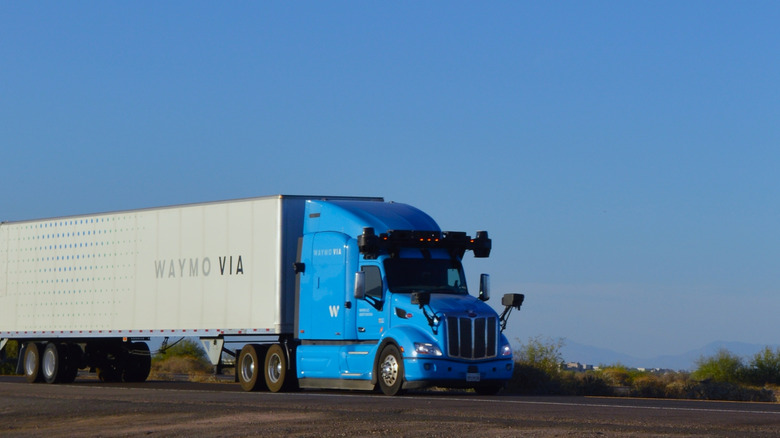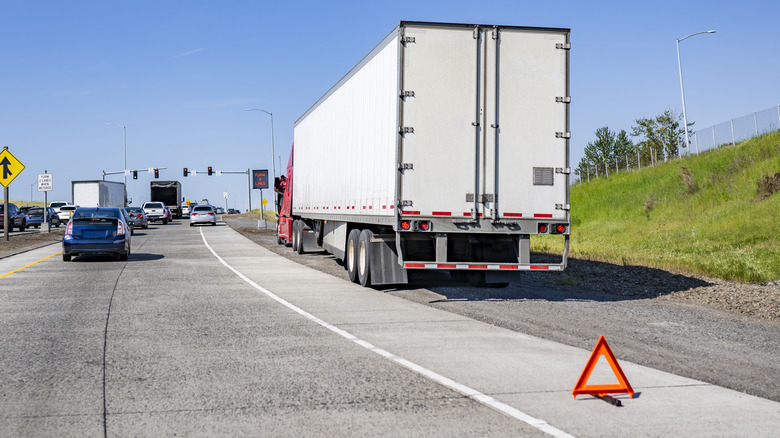This Obscure Law Could Slow Autonomous Trucking To A Crawl
Update 11/6/2025: Shortly after publication, Aurora reached out to SlashGear to let us know that it has been granted a waiver that allows it to use cab-mounted beacons on its autonomous trucks. More on that waiver and what it could mean for other autonomous vehicles below.
Autonomous driving is becoming increasingly widespread. Waymo self-driving cars are zipping passengers around more and more cities, while driverless AI trucks are hauling freight across Texas in trials. Yet one obscure law could bring any further advancement of this relatively new industry to a standstill.
Deep in the many pages of federal regulations governing the trucking industry lies Section 392.22 of Title 49, which outlines precisely what needs to happen when a commercial motor vehicle breaks down on the road. First, the vehicle's hazard warning signal flashers must be activated. The hazard lights must remain flashing until either three approved bidirectional emergency reflective triangles or at least six fusees/three liquid-burning flares are physically placed in very precise locations around the truck within 10 minutes.
While enacting the hazard warning signal system can easily be accomplished by the onboard computer or a remote operator, physically setting down warning markers can't be done without the presence of humans — especially because one must be placed exactly four paces (about 10 feet) from the stopped rig on the traffic side, in the direction of approaching traffic. Plus, a second device must be dropped 40 paces (100 feet) away from the vehicle in the same direction as approaching traffic, but this time either in the center of the traffic lane or shoulder, depending on where the truck is located. Finally, a third needs to be placed 40 paces in the same lane or shoulder, this time away from approaching traffic.
Self-driving freight company is pushing back against the regulation
While the testing phase has included observers physically sitting inside the trucks to take over in case of an emergency, the ultimate goal is for them to be devoid of any physical human presence at all. Besides perhaps a remote operator available to take control if needed, these trucks are supposed to be fully autonomous — which represents the crux of the problem.
Aurora, which began its self-driving trucking service in Texas in May 2025, applied for an exemption to Title 49, but was shot down by the Department of Transportation (DOT) in December 2024. Aurora even offered an alternative concept wherein they would attach brighter warning beacons to the front and back of the truck instead of using cones, warning triangles, and flares (which often get hit or burn out and become useless). Aurora fired back with a lawsuit in January 2025, alleging that the ruling was not only "arbitrary" and "capricious" but also "an abuse of federal regulators' discretion."
Regulators agreed to conduct research that could help answer the question of whether the use of such technology could be just as safe as manually implementing warning signs. Meanwhile, Rep. Vince Fong (R–Calif.) introduced theAMERICA DRIVES Act, with the goal of creating a national framework for the autonomous trucking industry. This would in part allow driverless rigs to use warning beacons instead of physically placed devices. However, Title 49 remains unchanged and in limbo while further studies are conducted. As it stands, autonomous driving appears to have hit a troubling plateau — at least in the trucking industry.
A new waiver allows some companies to use cab-mounted warning beacons
In October 2025, Aurora finally received a waiver that allows it to begin using cab-mounted warning beacons instead of the reflective triangles or liquid-burning flares on its Level 4 Automated Driving System equipped commercial motor vehicles. Previously, as outlined by the Federal Motor Carrier Safety Administration (FMCSA), the driver of a commercial vehicle was required to physically place warning indicators at specific locations around the truck. However, after further review, the FMCSA has stated that "it is in the public interest to grant the waiver to promote innovation and to enable commercial deployment of ADS CMVs to enhance safety and mobility for the American public."
The waiver is time-limited and only lasts from 12:01 a.m. on October 10, 2025, through 11:59 p.m. on January 9, 2026, at which time it will need to be reissued. Furthermore, and perhaps more importantly to the ADS CMV industry at large, it allows every other motor carrier to operate under the same waiver, as long as those companies can confirm their vehicles are equipped with cab-mounted warning beacons. They must also notify the agency in writing that they are complying with the regulations of the waiver.
There are some other specifications outlined in the waiver as well. In terms of scope, the waiver applies to vehicles primarily operating on the U.S. Interstate Highway System. It also restricts carriers from operating as for-hire or private passenger carriers. These types of vehicles can't transport hazardous materials, either.
The waiver comes with some additional fine print
As one might expect, there are several specifications these cab-mounted warning beacons must meet. First, they must be activated ASAP and no longer than 10 minutes after stopping. The warning beacons must also remain on throughout the entire event, from the moment the vehicle stops until it resumes regular operation. Additionally, the rig's standard hazard warning flashers must be turned on and remain on until the truck gets back on the road or is otherwise recovered.
Cab-mounted warning beacons must also be amber and meet Class 1 photometric performance requirements. Plus, they must have back up power sources to prevent potential failures. At least three of these beacons need to be installed: one on each side in the back and one in the front. They also can't make the vehicle jut out into the road too much, with the total permissible width of the vehicle with these beacons not allowed to exceed 122 inches. Furthermore, beacons need to be at least 100 inches above the ground, somewhere between the height of the side mirrors and the cab's roof. Finally, they need to flash in a pattern that is distinguishable from the standard hazard warning flashers aboard the truck.
The FMCSA withholds the right to terminate the waiver if the company fails to comply with any of its terms and conditions. It can also be discontinued if the beacons fall below the safety performance of reflective triangles or liquid-burning flares. These rights can also be revoked if cab-mounted lights are deemed to be no longer consistent with the goals and objectives of the agency.



